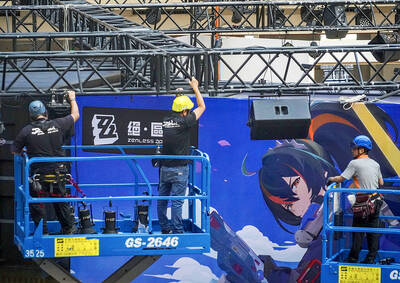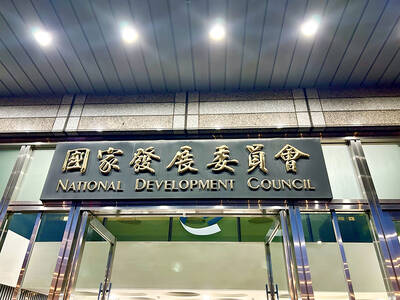Fighting between Syrian rebel and government forces eased yesterday as a Russian-led effort to shore up a ceasefire took effect, although battles continued on an important front line near Hama, a rebel commander and war monitor said.
The deal to make “de-escalation” zones in the major areas of conflict in western Syria took effect at midnight on Friday.
The initiative was proposed by Russia, Syrian President Bashar al-Assad’s most powerful ally, with the support of Turkey, which backs the opposition. Iran, al-Assad’s other major ally, also backed it.

Photo: AFP
Political and armed opposition groups have rejected the proposal, saying Russia has been unwilling or unable to get al-Assad and his Iranian-backed militia allies to respect past ceasefires.
Damascus said it backed the proposal, but added that it would continue to fight what it called terrorist groups across the country.
The Syrian Observatory for Human Rights said there had been a reduction in fighting across Syria since the deal came into force, but warned it was too early to say whether it would last.
“The reduction in violence must be clear and lasting,” observatory director Rami Abdulrahman told reporters.
The rebel commander said the general level of violence was reduced, but added: “Regime attempts [to advance] in the Hama countryside continue.”
With the help of Russia and Iranian-backed militias, the Syrian government has gained the military upper hand in the six-year conflict. The wide array of rebel groups include some supported by Turkey, the US and Persian Gulf monarchies.
The observatory said it had not recorded any deaths as a result of fighting in the four zones since midnight, but there had been some violations.
Breaches were seen mainly in northern Hama Governorate, where Syrian government and allied forces have taken territory from rebels in recent weeks.
Warplanes fired at the rebel-held village of al-Zalakiyat and nearby positions in the northern Hama countryside, where the combatants exchanged shelling, the Britain-based war monitoring group said.
The monitor said government forces shelled the nearby towns of Kafr Zita and al-Latamneh.
There was no immediate comment from the Syrian Army.
Mohammed Rasheed, a spokesman for the Jaish al-Nasr rebel group based in Hama, confirmed that fighting had broken out after midnight.
Rasheed said rebel-held Idlib Governorate to the north of Hama was almost completely quiet, but the attacks, which included barrel bombs, were focused on the northern Hama front line.
“The bombardment has not stopped; it is no different from before,” he told reporters.
Iran and Turkey on Thursday agreed to a Russian proposal for safe zones in Syria. The text of the memorandum was yesterday published by the Russian Ministry of Foreign Affairs.
The agreement said four safe zones would be established in Syria for a period of six months, which could be extended if the three signatory countries agree.
Weaponry and airstrikes were not to be used in those zones by combatants, the text said.
The agreement also included the creation of conditions for humanitarian access, medical assistance and the return of displaced civilians to their homes.

Taiwan is projected to lose a working-age population of about 6.67 million people in two waves of retirement in the coming years, as the nation confronts accelerating demographic decline and a shortage of younger workers to take their place, the Ministry of the Interior said. Taiwan experienced its largest baby boom between 1958 and 1966, when the population grew by 3.78 million, followed by a second surge of 2.89 million between 1976 and 1982, ministry data showed. In 2023, the first of those baby boom generations — those born in the late 1950s and early 1960s — began to enter retirement, triggering

ECONOMIC BOOST: Should the more than 23 million people eligible for the NT$10,000 handouts spend them the same way as in 2023, GDP could rise 0.5 percent, an official said Universal cash handouts of NT$10,000 (US$330) are to be disbursed late next month at the earliest — including to permanent residents and foreign residents married to Taiwanese — pending legislative approval, the Ministry of Finance said yesterday. The Executive Yuan yesterday approved the Special Act for Strengthening Economic, Social and National Security Resilience in Response to International Circumstances (因應國際情勢強化經濟社會及民生國安韌性特別條例). The NT$550 billion special budget includes NT$236 billion for the cash handouts, plus an additional NT$20 billion set aside as reserve funds, expected to be used to support industries. Handouts might begin one month after the bill is promulgated and would be completed within

The National Development Council (NDC) yesterday unveiled details of new regulations that ease restrictions on foreigners working or living in Taiwan, as part of a bid to attract skilled workers from abroad. The regulations, which could go into effect in the first quarter of next year, stem from amendments to the Act for the Recruitment and Employment of Foreign Professionals (外國專業人才延攬及僱用法) passed by lawmakers on Aug. 29. Students categorized as “overseas compatriots” would be allowed to stay and work in Taiwan in the two years after their graduation without obtaining additional permits, doing away with the evaluation process that is currently required,

IMPORTANT BACKER: China seeks to expel US influence from the Indo-Pacific region and supplant Washington as the global leader, MAC Minister Chiu Chui-cheng said China is preparing for war to seize Taiwan, Mainland Affairs Council (MAC) Minister Chiu Chui-cheng (邱垂正) said in Washington on Friday, warning that Taiwan’s fall would trigger a regional “domino effect” endangering US security. In a speech titled “Maintaining the Peaceful and Stable Status Quo Across the Taiwan Strait is in Line with the Shared Interests of Taiwan and the United States,” Chiu said Taiwan’s strategic importance is “closely tied” to US interests. Geopolitically, Taiwan sits in a “core position” in the first island chain — an arc stretching from Japan, through Taiwan and the Philippines, to Borneo, which is shared by